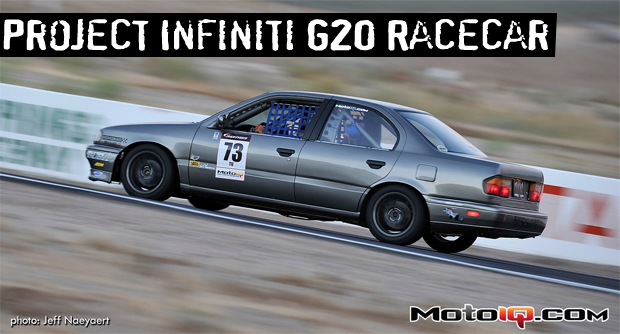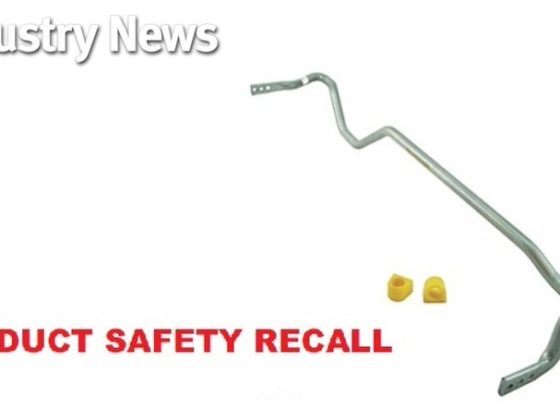,
 |
| Our Earl’s 16 row oil cooler mounted in an aluminum sheetmetal enclosure we built for it. As you can see, we’ve hit a couple of things with it. The air doesn’t mind the slightly wrinkled surface. We are in the process of fabricating a FOD screen for our oil cooler. In the meantime, the Earl’s unit has stayed leak free, despite being pummeled by desert rocks. |
To address our oil temp issues, we proceeded down the path less traveled. Generally, the standard operating procedure (SOP) when adding an oil cooler to a racecar is to bolt on a sandwich plate, run lines to/from the oil cooler, and use the oil pump as the method of fluid transfer. However, we felt that the SR20DE’s oil pump was overtaxed as it is, and adding an oil cooler to the oil pump’s circulation responsibilities; even with properly sized hoses, gradual bends, etc; was asking for more problems. Our solution? An electric fluid transfer pump from MOCAL. The key determinants in choosing the MOCAL fluid transfer pump were its temperature rating of up to 300*F, compatibility with nearly any type of lubricant, an indexable pump head, and the ability to self prime, allowing us to mount it wherever it was convenient. Weighing in at only 3.5lbs and with a 2 gallon per minute flow rate, we felt this pump would serve our needs perfectly. We wired our pump to the ignition through a relay to make sure no one forgets to turn the unit on prior to a race, and used Earl’s pipe thread to AN adapters to convert the pump’s 3/8” NPT fluid connections. The advantages of using the MOCAL pump to transfer oil instead of the oil pump are many. Since we are no longer worried about overall flow rate to the engine to keep lubrication up, we could use smaller lines that packaged better and weighed less. Gradual bend fittings were also not a concern, and we were able to run the more compact Earl’s 90* fittings. With a sandwich plate setup, if there is a leak or failure in the oil cooler circuit, oil pressure to the engine is diminished. This sometimes forces compromises in mounting location, or the need to add heavy bracing, since contact damage is always a concern. Lastly, if we have a failure or leak in the oil cooler circuit, or we have abnormally cool track temps that don’t allow the oil to get to proper temperature, we can simply disconnect power to the pump and our cooling loop is disabled.
 |
| Our MOCAL electric fluid transfer pump and -6AN Earl’s fittings and line. By using an electric pump to circulate oil to the cooler, we’ve reduced load on the oil pump, used tighter bends and smaller line to make packaging easier, and have the ability to easily shut the circuit down if necessary. |
For the cooler itself, we chose an Earl’s Temp-A-Cure 16 row unit with -6AN fittings mounted behind the passenger-side foglight hole in our Primera eGT bumper. This compact stacked plate unit is vacuum-brazed for superior sealing, and the corrugated screen and internal turbulator plates are thermally and structurally efficient, allowing for maximum cooling with minimum weight penalty. Since our car is already excessively nose-heavy, the less weight we add to the nose of this car, the better. To get oil to and from the engine, we welded -6AN bungs onto the oil pan, and plumbed the system with Earl’s Perform-O-Flex stainless hose, with Auto-Fit hose ends, which was cut exactly to length to reduce unneeded hose. We chose Perform-O-Flex stainless hose due to its ease of assembly (just wear gloves to reduce the amount of poking you get from frayed stainless braid) and superior reliability. Due to the location of our oil cooler, the last thing we want is leaks, as oil would dump right onto the front right tire! In order to ensure air flows through the cooler, instead of around it, we fabricated a 20 gauge aluminum sheetmetal enclosure for it that extends all the way to the bumper opening, forcing all incoming air through the cooler, with no escape paths. The splash guard was removed to promote evacuation of air behind the cooler.
 |
| More Earl’s fittings and lines. Seen here is our Autometer oil temperature sending unit as well. Because the tee our sender plugs into is isolated from ground, we used a hose clamp to secure a grounding wire to the sensor’s body. While the tee does have some ground, checking resistance with a digitial multimeter revealed that the ground was not very good. Poor grounds lead to inaccurate sensor readings. |
We filled our engine with Mobil 1 5w-30 oil. To ensure we had the proper amount of oil in the crankcase, we added the usual 4 quarts, turned the pump on to circulate the oil, and added oil until it reached the full line on the dipstick. Whenever you add an oil cooler to your engine, make sure to note how much oil volume it displaces. Otherwise, you run the risk of running your sump dry.
After years of racing, we decided to finally get an oil analysis done through Blackstone Labs, and were mildly alarmed at our results. While the oil showed healthy with plenty of additive remaining and proper viscosity (a sign we were keeping it cool enough), it did show higher than normal wear particles, and we have noticed slightly low oil pressure on hot days. We will experiment with thicker oil from a different vendor to see if this helps, and will of course keep you posted.
 |
| We welded two -6AN bungs to the factory oil pan to circulate oil through the cooler. Hot oil leaves the back of the pan to the cooler, and returns here, to the side pointed into the sump pickup, There is absolutely nothing to see in the top right corner of this picture. Move along folks… |



